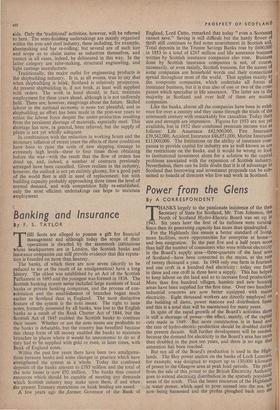Coal, Steel and Engineering
SCOTLAND'S motiern manufacturing industry was founded upon coal and is still largely dependent on coal. From the early nineteenth century. until 1913 expansion was continuous, some. 42,500.000 tons being raised in that year. Wars have had a serious effect upon coal production. At all events, 1920 saw the Scottish total down to 31,500,000 tons, While the Second World War led to a decline from 30,500,000 tons in 1939 to 22,630,000 tons in 1946. The end of the latter year brought the industry under State ownership, and the experience since then is indicated broadly by the fact that the saleable output last year showed a net rise of but 191,000 tons. This result is disappointing. One wonders how far it reflects a belief on the part of the miner that he both 'counts for something' and fares better financially when coal is scarce, and Whether it is unrelated to the fact that the leaders of the miners' union in Scotland have strong Communist sympathies. There are, of course, mitigating circumstances. Con- centration on production and neglect of development during the war years led to a more rapid exhaustion of the coal measures in the central field particularly, and when the National Coal Board assumed control they took over, in Scotland, 196 collieries-79 small collieries were left in private ownership to be operated under licence—many of which had gone under the margin of economic working. These latter properties must therefore be closed—but not too quickly, for demand for coalwas rising and could not be satisfied from new workings as yet non-existent. Progress, however, has been made, for 59 collieries have since been closed; and the resultant loss of output of some 1,500,000 tons annually—a figure indicating just how the older properties were being 'squeezed'— has been made good by reconstructions and extensions at existing collieries and by new development. The objective is a production by 1965 of 30,000,000 tons per annum with a labour force of 81,000. The output per manshift (o.m.s.) indicated in this objective is 28-29 cwt. At present the o.m.s. is just over 21 cwt. and the total manpower 85,250. It is clear that if the aim for the future is to be achieved some change of attitude is necessary.
Coal alone is not, of course, a sufficient basis for manufac- turing industry in a metallurgical age, and Scotland has been fortunate in that in the early years of the industrial era she combined coal with `blackband' ironstone. Deposits of the latter (operated first in 1801) have long been worked out, but the combination laid the foundation of the industrial structure that has since been built, a foundation first expressed in terms of iron and in more recent times in terms of steel. The basis of production is now, increasingly, imported ore, but geographical location tends, in comparison, to affect costs adversely, and efforts are thus made to secure the largest possible tonnages of scrap for re-melting. The 'pull' on industry resulting from the shift eastwards of the centre of coal production has, inciden- tally, given rise to suggestions from time to time that the steel industry must be re-sited on the Firth of Forth coast. That this transfer is not, however, contemplated in authoritative quarters is clear from the considerable modernisation and extension of plant in the West of Scotland. Large-scale pro- duction is now the order. side. Only the 'traditional' activities, however, will be referred to here. The semi-finishing undertakings are mainly organised within the iron and steel industry, these including, for example, sheetmaking and bar re-rolling; but several are of such size and scope as to claim status as industries themselves, and cannot in all cases, indeed, be delineated in this way. In the latter category are tube-making, structural engineering, and light castings manufacture. Traditionally, the major outlet for engineering products is the shipbuilding industry. It is, at all events, true to say that when shipbuilding is brisk, Scotland is relatively prosperous. At present shipbuilding is, if not brisk, at least well supplied with orders. The work in hand should, in fact, maintain employment for three years ahead, although it is not uniformly held. There are, however, misgivings about the future. Skilled labour in the national economy is none too plentiful, and in shipbuilding an effort has been made in the post-war years to retain the labour force despite the under-production resulting- • from the persistent shortage of materials, especially steel. This shortage has now, in general, been relieved, but the supply of plates is not yet wholly adequate. In combination with the reduction in working hours and the monetary inflation of recent years the effects of these conditions have been to raise the costs of new shipping. tonnage to extremely high levels—three to four times those obtaining before the war—with the result that the flow of orders has dried up, and, indeed, a number of contracts previously arranged have been cancelled. Given realism in the industry, however, the outlook is not yet entirely gloomy, for a good part of the world fleet is still in need of replacement; but with building capacity probably approaching three times the level of normal demand, and with competition fully re-established, only the most efficient undertakings can hope to maintain employment.



































































 Previous page
Previous page